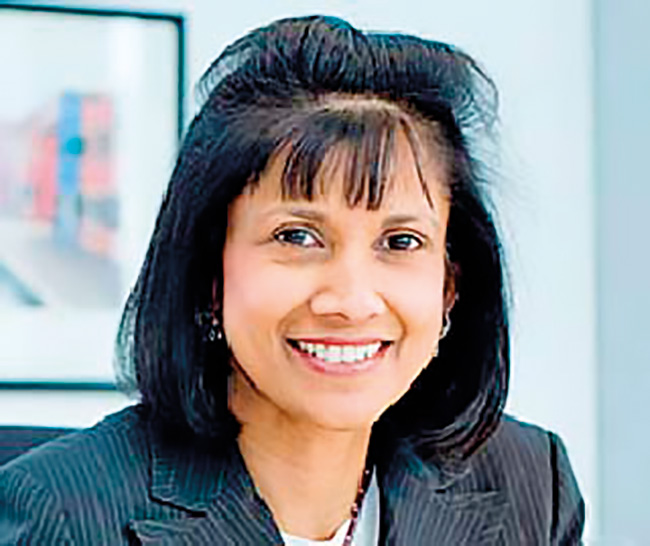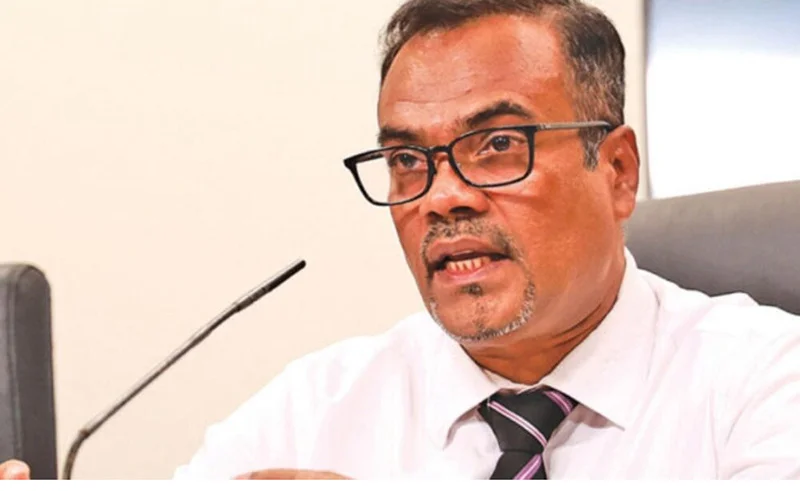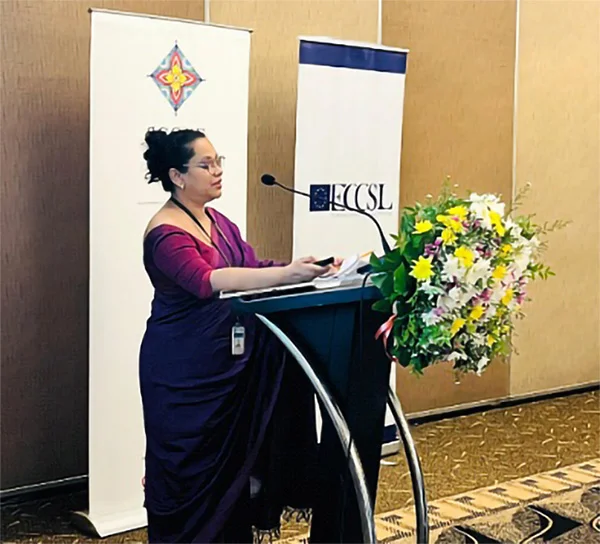Business
‘You have my sympathy’, Sharmini Coorey tells Sri Lanka’s economic policymakers

‘Sri Lanka cannot afford yet another replay of the old script’
‘People would know good governance when they see it’
by Sanath Nanayakkare
Dr. Sharmini Coorey last week expressed her understanding and sympathy with the Sri Lankan economic policymakers and the Central Bank of Sri Lanka (CBSL) for getting the blame from the general public as they were taking ‘corrective’ measures to rescue a faltering economy, without which it could ‘give way’ to another economic collapse in the years to come.
Dr. Coorey, Member of the Presidential Advisory Group on Multilateral Engagement and Debt Sustainability advising the government of Sri Lanka and a former Department Director of the International Monetary Fund (IMF) made this remark while delivering the 73rd Anniversary Oration of Central Bank of Sri Lanka (CBSL) on 01st November 2023 at the CBSL Head Office in Colombo.
Her oration was centred on the theme “The Way Forward: Price Stability and Prosperity Need Good Governance.
Addressing the policymaking and financial community in the audience she first recognised the talented and hardworking leaders and members of the CBSL staff and those on the policymaking front for taking on a ‘very challenging’ year and a half since April 2022 where they took ‘bold’ decisions in terms of technical work to stabilise the economy out of the deepest economic crisis that Sri Lanka has ever suffered.
Addressing the audience she said: “It is perhaps easy to take for granted the progress made so far. But let’s not forget that barely 20 months ago, Sri Lanka’s inflation was unanchored, the exchange rate was depreciating uncontrollably, foreign reserves were depleted and the economy was collapsing with shortages of food, fuel and essential medicine. However, you have been able to bring the inflation down from almost 74% in September 2022 to less than 2% a year later beating the projections. To accomplish this, financial stability was all the more important given the deep economic contraction together with the preceding pandemic which had dented financial sector balance sheets. The monetary policy was also responsive in lowering the policy rates as clear evidence was emerging that monthly inflation was stabilizing.”
“Let me say, based on my years of experience at the IMF working with countries around the world – often during economic stress – these are, by any standards, impressive accomplishments. Without skilled leadership and decision making the situation would have been a lot worse.”
“Deep monetary policy decisions were successful also because of the support from the government’s fiscal policy and the leeway given to the CBSL to conduct monetary policy according to its best judgment. Tax cuts from the previous government had reduced Sri Lanka’s tax ratio from 11% of GDP in 2019 to a mere 7.5% of GDP in 2020/21- one of the lowest in the world – lower even than very poor countries like Central African Republics. With interest rates taking up 73% of our revenue and the overall fiscal deficit of 12% of GDP in 2021, the fiscal position was not simply sustainable. The government took necessary steps to increase tax rates, tax collection and implement cost-recovery pricing in energy. Efforts were made to generate the needed improvements in the primary fiscal balance in line with the IMF-supported programme.”
“These were difficult decisions. They were politically unpopular, but were necessary. Unfortunately, the shift thus taken cannot turn around the economy quickly. So, people tend to blame the corrective approach to policymaking when the policymakers are doing the right thing rather than the reckless policies of the past that were fundamentally flawed. Such is the unenviable position of the policymakers who stepped into rescue their country from the crisis. So you have my sympathy.”
“So what now? Even though significant progress has been achieved, we are in a low level of equilibrium with our economic performance below potential. This crisis is not yet over. The only way out is to grow at a rate of about 5 or 6% a year in a sustainable and inclusive way. Without such work, we cannot escape our high debt burden even after a successful debt restructuring. And because the debt burden lies with the public sector, it will need to contract not just this year but also in the decade ahead. So growth will need to come from the private sector and be export-oriented given our foreign exchange need. There is simply no other option.”
“Much remains to be done to get the economy on a dynamic growth trajectory. It shouldn’t be taken for granted that having achieved your inflation target, it will stay within CBSL’s target of 5% or that the progressive fiscal endeavor would continue. Our post-independence economic history is full of stopgap policies and brief victories of stability that were not sustained. We cannot afford yet another replay of that familiar script. Why not? Well, this time it is really different for three reasons.”
According to the IMF even if we successfully restructure our debt and adhere to the tight policies that would generate a primary fiscal surplus of 2.2% of GDP , from 2025 until at least 2032, our public debt would decline to only about 95% of GDP by 2032 from about 130% of GDP now. By 2032, government debt to GDP would average 65%. Looking at our neighbours, this number is 55% in India, 40% in Indonesia and 54% in Thailand. So, unless we bring debt to GDP ratio to about 60-80% of GDP, the baseline debt ratio will be much higher. Sri Lanka will be at a higher risk of debt distress even after a successful debt restructuring. If we become complacent and go back to our past ways, we could easily go back to a crisis where we are unable to pay our debts. In such a context, the adjustments next time would be far more painful because we would already have restructured our domestic and external debt.
More people are now in poverty according to World Bank estimates and have little cushion against it. The UNDP has estimated that over a half the population grapples with multidimensional vulnerability. The World Food Programme has estimated that 31% of children aged under 5 are malnourished. Many people grapple with basic needs such as healthcare. Progressive education has been severely hampered as a result of the pandemic and the economic crisis. So, the impact of another debt default would entail adjustments that would be disastrous and would lead to social unrest.
Sri Lanka has suffered from a damaging outflow of professionals who are the backbone of economic recovery and growth. These professionals are leaving not merely because of taxes as is often said. They have lost hope because of the corruption Sri Lanka has been mired in for decades. They don’t see a future in a country where they don’t see the culprits are punished. We have also been vulnerable to many exogenous shocks like wars, higher world interest rates, poor agricultural harvests and natural disasters. We are on a knife-edge and there is no room for policy reversals.
“But, with the focus on progressive efforts, we can shift to a path of sustained growth and inclusive prosperity. What is the way forward? How can we avoid stop gap policies? For this we need, fiscal discipline, an open trade regime that encourages exports, protective markets, modernized labour laws and adequate infrastructure. I believe our fundamental problem is our poor governance. Unless we address that issue head on, we can’t overcome our economic problems and prosper. So, when we discuss economic policies, we need to primarily focus on the governance around those policies. What do we mean by good governance? There is no standard definition. But people know good governance when they see it.”
“My point today is not just about economic policies, for instance, whether interest rates or taxes or a particular SOE should be privatized or not. It is about ensuring policymaking and implementation more accountable, transparent and getting them to adhere to the rule of law and so on, which will improve the results of the economic policies. Good policymaking needs to be backed by strong institutions. It requires sustained social pressure to take on the vested interests that are served by poor governance. We need to ensure that policies serve the interests of not just a small group but an inclusive society,” Dr. Sharmini Coorey said.
Business
President AKD writes to President Trump over trade deficit concerns

In a bid to address mounting trade tensions, the Sri Lankan government has intensified efforts to reduce its significant trade deficit with the United States, Deputy Minister of Economic Development Dr. Anil Jayantha Fernando announced in parliament yesterday. He added that President Anura Kumara Dissanayake has despatched a formal letter to President Trump urging, among other things, a re-assessment of the recent enhanced tariff regime imposed on Sri Lanka.
The move follows reciprocal tariffs imposed by U.S. President Donald Trump, which Sri Lankan authorities say significantly affect key export sectors. The Deputy Minister indicated that the White House has acknowledged receipt of the Lankan President’s letter, signaling the launching of a potential bilateral dialogue.
Responding to a question raised by New Democratic Front (NDF) MP Ravi Karunanayake, Deputy Minister Fernando revealed that 88% of Sri Lanka’s trade deficit over the past five years stemmed from U.S. trade relations with apparel, rubber products, spices, other agricultural products and precious gems constituting 85% of total exports to the U.S. These exports, he noted, already face tariffs and paratariffs, but President Trump’s recent levies were calculated based on bilateral trade imbalances – a factor that has placed Sri Lanka’s economy under heightened pressure.
“The President’s intervention underscores our commitment to protecting Sri Lankan industries and fostering equitable trade terms, Fernando stated, defending the administration’s proactive and reactive measures to mitigate the US tariffs’ impact on local businesses.
Highlighting ongoing engagement, he added that another round of high-level discussions with the Office of the U.S. Trade Representative (USTR) was scheduled overnight. These talks aim to address structural trade imbalances and explore avenues for tariff relief, particularly for Sri Lanka’s apparel sector, which employs millions nationwide.
The President’s letter marks a strategic move in Sri Lanka’s diplomatic outreach, reflecting the government’s urgency to stabilise an economy still recovering from recent crises while in the middle of an IMF programme.
Sri Lankan industry leaders have cautiously welcomed the government’s efforts but emphasise the need for swift, tangible outcomes.
At present, all eyes remain on Washington’s response to President Dissanayake’s appeal – a potential turning point for Sri Lanka’s trade future, observers noted.
By Sanath Nanayakkare
Business
Inclusive and sustainable apparel for SDGs

The European Chamber of Commerce of Sri Lanka (ECCSL), in collaboration with the Strengthening Social Cohesion and Peace in Sri Lanka (SCOPE) programme, recently hosted its third industry-focused event, bringing together apparel-sector stakeholders to exchange experiences and practical insights on embedding inclusivity and sustainability into business operations.
Building on the success of ECCSL’s earlier events focused on tourism and food and agriculture, this apparel-focused gathering convened government representatives, industry leaders, business practitioners and the academia to discuss practical strategies for embedding inclusivity and sustainability into business operations.
While many businesses already recognize the importance of these principles, the event emphasized practical implementation, shifting the conversation from the “why” to the “how” of inclusive and sustainable practices.
Chamindry Saparamadu, Director General of the Sustainable Development Council of Sri Lanka, discussed how the Government of Sri Lanka is supporting businesses to create social and environmental impact through its Inclusive and Sustainable Business (ISB) Strategy. Ms. Saparamadu outlined how this strategy aims to create a resilient, equitable, and sustainable economy by building an ecosystem in which inclusive and sustainable businesses can thrive, driving transformative change across industries.
The event also featured engaging presentations from leading apparel businesses—Omega Line, Hirdaramani, and Compreli Consulting—each showcasing real-world examples of how inclusivity and sustainability can be embedded into business operations.
Omega Line, represented by Saman Jayasinghe (Chief HR Officer, Group – Administration) and Charman Dep (Assistant General Manager – Production Planning), presented its multifaceted sustainability approach, spotlighting its Vavuniya factory as a successful model for combining environmental stewardship with social impact.
Hirdaramani’s Manindri Bandaranayake (Chief Brand & Sustainability Officer for Sri Lanka, Bangladesh, Ethiopia, and Vietnam) showcased the company’s holistic sustainability framework, including its Wonders of Wellbeing (WOW) program, policies supporting differently-abled individuals, and deep community engagement.
Finally, Compreli Consulting co-founders Ramesh De Silva and Shehan Olegasageram showcased their innovative garment repair-as-a-service model—a circular, scalable solution that reduces waste and carbon emissions, while aligning with evolving global sustainability regulations.
Participants then had the opportunity to share their own knowledge in a group discussion, exchanging experiences and reflecting on the challenges and opportunities encountered in their sustainability journeys.
The event underscored the collective benefit of building Sri Lanka’s reputation as a global leader in inclusive and sustainable business. By fostering collaboration between businesses, the academic community and government stakeholders, the session aimed to accelerate broader industry adoption of these principles and contribute to Sri Lanka’s sustainable economic growth.
The discussions were facilitated by the Project Lead of ECCSL’s Inclusive Business Practices project, William Baxter.
Business
Union Assurance records Rs. 5.2 Billion PBT, fortifying its financial position by delivering best-in-class value

Union Assurance PLC, Sri Lanka’s longest-standing private Life Insurer, has recorded a strong financial performance with growth across key metrics for the year ending December 31, 2024. The Company achieved a 15% growth in gross written premium, totalling Rs. 21.6 billion driven by double-digit growth in both regular new business premiums and renewal premiums and paid Rs. 7.7 billion worth of claims and benefits to its customers during the year. In addition, for the year ending December 2024, the Company also declared an industry-leading universal life policyholder dividend rate of 12%, underscoring its continued commitment to deliver exceptional value to its customers.
Net investment income recorded a 9% year-on-year growth to reach Rs. 11.8 billion aided by an effective asset allocation strategy. The gains from the trading investment portfolio increased by 123% to reach Rs. 2.9 billion driven by the strong performance of the Colombo Stock Exchange during the latter part of the year.
Union Assurance distributed Rs. 3 billion as surplus from the policyholder fund and reported a profit after tax of Rs. 3.7 billion for 2024. The Company declared a final shareholder dividend of Rs. 5.00 per share amounting to a total payout of Rs. 2.9 billion.
A key milestone for Union Assurance in 2024 was the surpassing of Rs. 100 billion in total assets for the first time in its history, ending the year with Rs. 109.5 billion. This underscores the Company’s solid financial foundation and growth trajectory.
The Company’s assets under management grew by 15% during the year, reaching Rs. 95.6 billion driven by market valuation gains and cash generation from business operations. Furthermore, Union Assurance’s capital adequacy ratio stood at a healthy 264% at the end of 2024, well above the regulatory minimum of 120%.
-

 Business3 days ago
Business3 days agoColombo Coffee wins coveted management awards
-

 Business5 days ago
Business5 days agoDaraz Sri Lanka ushers in the New Year with 4.4 Avurudu Wasi Pro Max – Sri Lanka’s biggest online Avurudu sale
-

 Features4 days ago
Features4 days agoStarlink in the Global South
-

 Business6 days ago
Business6 days agoStrengthening SDG integration into provincial planning and development process
-

 Business5 days ago
Business5 days agoNew SL Sovereign Bonds win foreign investor confidence
-

 Sports7 days ago
Sports7 days agoTo play or not to play is Richmond’s decision
-

 Features4 days ago
Features4 days agoModi’s Sri Lanka Sojourn
-

 Midweek Review14 hours ago
Midweek Review14 hours agoInequality is killing the Middle Class













